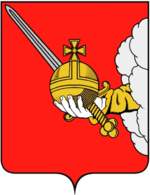Globus cruciger
This article includes a list of general references, but it lacks sufficient corresponding inline citations. (November 2014) |
The cross laid over the globus represents Christ's dominion over the world, literally held in the hand of a worthy earthly ruler. In the iconography of Western art, when Christ himself holds the globe, he is called Salvator Mundi (Latin for 'Saviour of the World'). For instance, the 16th-century Infant Jesus of Prague statue holds a globus cruciger in this manner.
History

Holding the world in one's hand, or, more ominously, under one's foot, has been a symbol since antiquity. To citizens of the
The first known depiction in art of the symbol was probably in the early 5th century AD, possibly as early as AD 395, namely on the reverse side of the coinage of Emperor Arcadius, yet most certainly by AD 423 on the reverse side of the coinage of Emperor Theodosius II.
The globus cruciger was associated with powerful rulers and
Gallery
-
Emperor Frederick I Barbarossa
-
The Golden Bull of 1356 by the Charles IV, Holy Roman Emperor
-
Frederick V holding the orb
-
Elizabeth I of England in coronation robes, with orb and sceptre
-
Primary Crown Jewels of the United Kingdom, with Sovereign's Orb at upper left (in late 1952 before the coronation of Elizabeth II)
-
Dutch globus cruciger, part of the Regalia of the Netherlands
-
Regalia of Sweden with the orb
-
Regalia of Russia
-
Holy Crown, Sword and Globus Cruciger of Hungary
-
Coat of arms of Vologda
-
Orb and sceptre in the coat of arms of Montenegro; several other coats of arms use them in the same manner.
-
Chromolithograph of Jesus as a child, holding an orb and a crown of thorns
-
Statue of Virgin Mary holding an orb
-
The Harris tweed orb
-
Wall sculpture in Sainte-Chapelle, Paris
Use as an alchemical symbol
The globus cruciger was used as the alchemical symbol (♁) for antimony. It was also used as an alchemical symbol for lupus metallorum "the grey wolf", supposedly used to purify alloyed metals into pure gold. Lupus metallorum (stibnite) was used to purify gold, as the sulphur in the antimony sulphide bonds to the metals alloyed with the gold, and these form a slag which can be removed. The gold remains dissolved in the metallic antimony which can be boiled off to leave the purified gold.[2]
See also
- The Ball and the Cross
- Holy Hand Grenade of Antioch
- Monde (crown)
- Earth symbol
- Celestial spheres
- T and O map
- Apfelgroschen – coin depicting the orb and cross of the Holy Roman Empire
- Venus symbol
References
- Leslie Brubaker, ISBN 0-684-18161-4
- Picture of the 10th century Orb, Scepter and Crown insignia of the Holy Roman Empire
- Stockdale, D. (1924). "Historical Notes on the Assay of Gold". Science Progress in the Twentieth Century. 18 (71): 476–479. JSTOR 43430908.
External links
 Media related to Globus cruciger at Wikimedia Commons
Media related to Globus cruciger at Wikimedia Commons





















